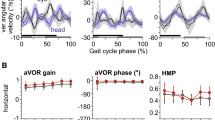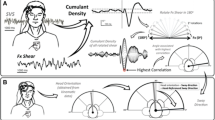Summary
-
1.
Geckos adapt their head-position to the spatial orientation of substrates they are actively moving on. Furthermore an adaptation of head-position is carried out in response to structures in the animal's vicinity. We found a tendency to keep the ventral side of the head orientated towards such objects. Thus, in geckos, visual guidance overrides vestibular mechanisms inducing compensatory head-movements during abnormal body postures in many other species.
-
2.
Compensatory head-movements during optokinetic, vestibular, and combined optokinetic and vestibular stimulation in restrained geckos also revealed a dominant role of vision in guiding postural control in these animals. Vestibular influences on head-position are weak as long as optokinetic cues are absent. With optokinetic stimulation present vestibular afferents significantly increase the gain of the optokinetic response. This effect is the more obvious the higher the optokinetic stimulation speed is.
-
3.
When a head-position deviating from the normal position has been actively assumed in response to either one of the above conditions it is not instantaneously abolished after the inducing stimulus ceases to be present. The head returns to a position normal with respect to the body by a slow drift that takes several minutes. This drift is faster when visual stabilization is interrupted by darkness as compared to a situation with the experimental room illuminated.
-
4.
We conclude that geckos have integrators through which postural change commands (e.g. from the visual system) are fed before interacting with postural control circuits. These mechanisms maintain actively assumed abnormal postures after cessation of the inducing command. Comparative investigations suggest that such mechanisms are present in many species of lizards and are especially well developed in animals that frequently assume different body orientations with respect to the gravity vector in their habitat.
Similar content being viewed by others
Abbreviations
- VSR :
-
ventral substrate response
References
Butz-Kuenzer, E.: Optische und labyrinthäre Auslösung der Lagereaktionen bei Amphibien. Z. Tierpsychol.14, 429–447 (1957)
Dichgans, J., Schmidt, C.L., Graf, W.: Visual input improves the speedometer function of the vestibular nuclei in the goldfish. Exp. Brain Res.18, 319–322 (1973)
Feng, A.: The role of the electrosensory system in postural control of the weakly electric fishEigenmannia virescens. J. Neurobiol.8, 429–437 (1977)
Graf, W. Meyer, D.L.: Eye positions in fishes suggest different modes of interaction between commands and reflexes. J. Comp. Physiol.128, 241–250 (1978)
Grüttner, R.: Experimentelle Untersuchungen über den optokine-tischen Nystagmus. Z. Sinnesphysiol.68, 1–48 (1939)
Holst, E. von, Mittelstaedt, H.: Das Reafferenzprinzip. Naturwissenschaften37, 464–476 (1950)
Magnus, R.: Körperstellung. Berlin: Springer 1924
Meyer, D.L., Bullock, T.H.: The hypothesis of sense-organ-dependent tonus mechanisms: History of a concept. Ann. N.Y. Acad. Sci.290, 3–17 (1977)
Meyer, D.L., Bonnemann, D., Schaefer, K.-P.: Equalization of asymmetries of tonus in the optomotor system of rabbits. A study on oculomotor neurons. Exp. Brain Res.18, 505–511 (1973)
Meyer, D.L., Heiligenberg, W., Bullock, T.H.: The ventral substrate response. A new postural control mechanism in fishes. J. Comp. Physiol.109, 59–68 (1976a)
Meyer, D.L., Platt, C., Distel, H.-J.: Postural control mechanisms in the upside-down catfish (Synodontis nigriventris). J. Comp. Physiol.110, 323–331 (1976b)
Meyer, D.L., Becker, R., Graf, W.: The ventral substrate response of fishes. Comparative investigation of the VSR about the roll and the pitch axis. J. Comp. Physiol.117, 209–217 (1977)
Robinson, D.A.: On the nature of oculomotor connections. Invest. Ophthalmol.11, 497–503 (1972)
Schaefer, K.-P., Meyer, D.L.: Compensation of vestibular lesions. In: Handbook of sensory physiology, Vol. VI/2, pp. 463–490. Kornhuber, H.H. (ed.). Berlin, Heidelberg, New York: Springer 1974
Schaefer, K.-P., Wehner, H.: Zur pharmakologischen Beeinflussung zentralnervöser Kompensationsvorgänge nach einseitiger Labyrinthausschaltung durch Krampfgifte und andere erregende Substanzen. Naunyn Schmiedebergs Arch. Pharmakol.254, 1–17 (1966)
Traill, A.B., Mark, R.F.: Optic and static contributions to ocular counter-rotation in carp. J. Exp. Biol.52, 109–124 (1970)
Author information
Authors and Affiliations
Additional information
This study was supported by grants from the „Deutsche Forschungsgemeinschaft“ to D.L. Meyer (ME 526/6 + 8) and NIH, NSF and NASA grants to Dr. T.H. Bullock
We thank Mr. Clausen for his constant help with many of the experiments and Dr. T.H. Bullock for valuable suggestions and reading the manuscript. Furthermore we are indebted to Prof. Kerr and Prof. Junk for providing us with an opportunity to perform part of this investigation in INPA/Manaus-Brazil.
Rights and permissions
About this article
Cite this article
Meyer, D.L., Graf, W. & Seydlitz-Kurzbach, U.v. The role of integrators in maintaining actively assumed abnormal postures. J. Comp. Physiol. 131, 235–246 (1979). https://doi.org/10.1007/BF00610431
Accepted:
Issue Date:
DOI: https://doi.org/10.1007/BF00610431




